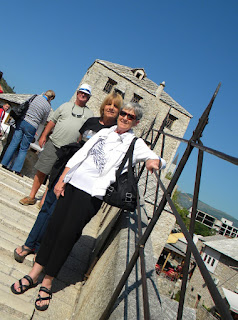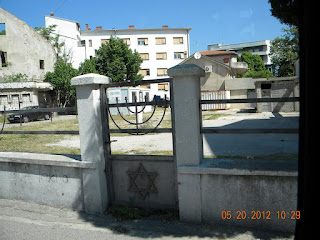Sunday, May 20th
We were all up early by 5:30 a.m. and began pulling ourselves and
luggage together for our 6 a.m. departure from our home for three nights of
very restful sleep. Unexpectedly, the power
went out and we were left with the natural light of a few windows. However, remembering the pre-trip advice to
be like the Who’s in Whoville, the power outage didn’t faze us and we left 5
minutes early, saying goodbye to the lines of drying laundry throughout the
city.
We arrived in Mostar, which was heavily damaged in the
war. A river runs through the town and
the Croatian and Bosnian sections of the city are separated by the bridge that
crosses the river. Residents are mainly
Muslims and Christians. There are markets of crafts persons on both sides of
the bridge and quite a few cafes with a variety of drinks including the
traditional very strong and black Turkish coffee. We spent less than two hours in Mostar, but
did manage to have coffee cross; to the bridge and back and to see the young
man who sits on the railing of the bridge, 28 meters above the water and is
willing to dive into the water for a fee.
(We choose not to watch him risk his life and limbs – too nerve racking
for any of us.) (See photos)
The most compelling sight to me was an old painting on
cardboard of a Muslim and Non-Muslim man sharing coffee. If only we could sit with each other and
share coffee and conversation more often…our world might be a much more
peaceful place.
We continued on our way to Sarajevo in hopes of arriving in
time to see the Sarajevo Haggadah in the
Sarajevo museum. (I you enjoy novels
and haven’t read The People of the Book, it is a fictional account of the
creation of and history of the Sarajevo Haggadah and an excellent read.) Unfortunately, the Haggadah is only on
exhibit twice a year. We arrived on
Sunday and it had been displayed on Saturday!
(The website hadn’t told us that.)
So, we continued on our way to find our hotel. This was quite a feat, and Guy did some of
the best sidewalk parking (allowed in Croatia) in the history of the
world. However, we could not locate the
hotel and while in search of directions, Peggy discovered an angel, Ariana, who
offered to go with us to the hotel.
(See photos) On finding the
hotel, she discovered and old friend working there and also helped us with
directions to two highly recommended places for lunch of cevapci beef sausage on warm pita bread with chopped
onions – a must in Bosnia and fantastic and yogurt drink at Ziljos followed by
ice cream at Egipto’s. The bakery / ice
cream shop is reputed to be one of the best in the world. Local lore has it
that during the war, when the whole area was destitute, the owner was offered one
million dollars for the ice cream recipe and refused the offer. It is exquisite and has a texture unlike any
other ice cream. So when in Sarajevo,
so as the locals do and check out Zlijos and Egipt.
While at Egipt, we ran into a Bostonian, who recommended a
number of great restaurants including Pod Lipom, a place visited by Pres.
Clinton in 1998 and still reputed to be among the best restaurants. We enjoyed dinner there and it was one of
the best meals of the trip with undoubtedly the best bread ever! The waiter suggested we try a sampling of
traditional Bosnian food, which we did (See photos) and enjoyed every bite all
the way through sopping up the juices with the memorable bread.
Earlier in the afternoon we visited the Orthodox cathedral,
with plans on visiting the other places of worship the next morning. We also discovered Taslihan (the remnants of
a 16th century caravan stop) next to one of the most modern hotels
in Sarajevo. (See photos)
Must confess we also spent a bit of time shopping and searching for gifts for kids back home and ourselves. However, children are not high on the list of souvenir inventories, so our search was in vain. We eventually gave up and simply enjoyed the people and ambiance of Sarajevo. Signs of the war still abound and war damaged buildings sit next to renovated and new structures. There are quite a few brightly colored buildings, perhaps a sign of hope for a brighter and better world. Universally, everyone we talked to said the people did not want the war. The various ethnic and religious groups were friends and got along, but people in power wanted more power and there was war at great cost to hundreds of thousands of men, women, and children. Across Croatia, the signs of war remain in destroyed, damaged, and abandoned buildings (including our grandfather’s home) and the sadness and senselessness of war sinks in and makes us ask why and pray for an end to violence and wars.

































fascinating encounters, and so illuminating.
ReplyDelete